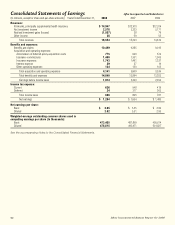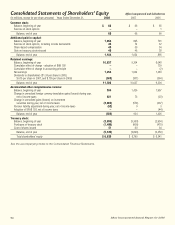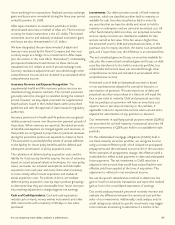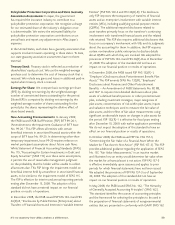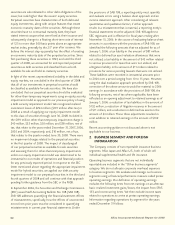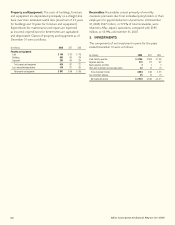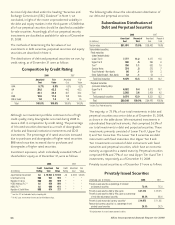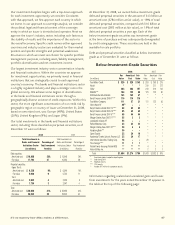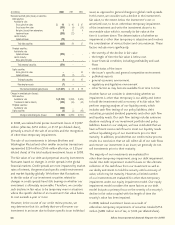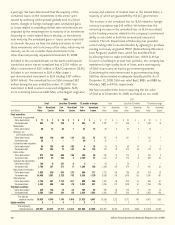Aflac 2008 Annual Report Download - page 66
Download and view the complete annual report
Please find page 66 of the 2008 Aflac annual report below. You can navigate through the pages in the report by either clicking on the pages listed below, or by using the keyword search tool below to find specific information within the annual report.
62 Aflac Incorporated Annual Report for 2008
securities are subordinated to other debt obligations of the
issuer, but rank higher than the issuers’ equity securities.
Perpetual securities have characteristics of both debt and
equity investments, along with unique features that create
economic maturity dates of the securities. Although these
securities have no contractual maturity date, they have
stated interest coupons that were fixed at their issuance and
subsequently change to a floating short-term rate of interest
of 125 to more than 300 basis points above an appropriate
market index, generally by the 25th year after issuance. We
believe this interest step-up penalty has the effect of creating
an economic maturity date of the perpetual securities. Since
first purchasing these securities in 1993, and until the third
quarter of 2008, we accounted for and reported perpetual
securities as debt securities and classified them as both
available-for-sale and held-to-maturity securities.
In light of the recent unprecedented volatility in the debt and
equity markets, we concluded in the third quarter of 2008
that all of our investments in perpetual securities should
be classified as available-for-sale securities. We have also
concluded that our perpetual securities should be evaluated
for other-than-temporary impairments using an equity security
impairment model as opposed to our previous policy of using
a debt security impairment model. We recognized realized
investment losses of $294 million ($191 million after-tax) in
2008 as a result of applying our equity impairment model
to this class of securities through June 30, 2008. Included in
the $191 million other-than-temporary impairment charge is
$40 million, $53 million, $50 million, and $38 million, net of
tax, that relate to the years ended December 31, 2007, 2006,
2005 and 2004, respectively; and, $10 million, net of tax,
that relates to the quarter ended June 30, 2008. There were
no impairment charges related to the perpetual securities
in the first quarter of 2008. The impact of classifying all
of our perpetual securities as available-for-sale securities
and assessing them for other-than-temporary impairments
under our equity impairment model was determined to be
immaterial to our results of operations and financial position
for any previously reported period. In response to the SEC
letter mentioned above regarding the appropriate impairment
model for hybrid securities, we applied our debt security
impairment model to our perpetual securities in the third and
fourth quarters of 2008 and will continue with that approach
pending further guidance from the SEC or the FASB.
In September 2006, the Securities and Exchange Commission
(SEC) issued Staff Accounting Bulletin No. 108 (SAB 108).
SAB 108 addresses quantifying the financial statement effects
of misstatements, specifically, how the effects of uncorrected
errors from prior years must be considered in quantifying
misstatements in current year financial statements. Under
the provisions of SAB 108, a reporting entity must quantify
and evaluate errors using a balance sheet approach and an
income statement approach. After considering all relevant
quantitative and qualitative factors, if either approach
results in a misstatement that is material, a reporting entity’s
financial statements must be adjusted. SAB 108 applies to
SEC registrants and is effective for fiscal years ending after
November 15, 2006. In the course of evaluating balance sheet
amounts in accordance with the provisions of SAB 108, we
identified the following amounts that we adjusted for as of
January 1, 2006: a tax liability in the amount of $87 million
related to deferred tax asset valuation allowances that were
not utilized; a tax liability in the amount of $45 million related
to various provisions for taxes that were not utilized; and
a litigation liability in the amount of $11 million related to
provisions for various pending lawsuits that were not utilized.
These liabilities were recorded in immaterial amounts prior
to 2004 over a period ranging from 10 to 15 years. However,
using the dual evaluation approach prescribed by SAB 108,
correction of the above amounts would be material to 2006
earnings. In accordance with the provisions of SAB 108, the
following amounts, net of tax where applicable, have been
reflected as an opening adjustment to retained earnings as of
January 1, 2006: a reduction of tax liabilities in the amount of
$132 million; a reduction of litigation reserves in the amount
of $11 million; and a reduction in deferred tax assets in the
amount of $4 million. These three adjustments resulted in
a net addition to retained earnings in the amount of $139
million.
Recent accounting guidance not discussed above is not
applicable to our business.
2. BUSINESS SEGMENT AND FOREIGN
INFORMATION
The Company consists of two reportable insurance business
segments: Aflac Japan and Aflac U.S., both of which sell
individual supplemental health and life insurance.
Operating business segments that are not individually
reportable are included in the “Other business segments”
category. We do not allocate corporate overhead expenses
to business segments. We evaluate and manage our business
segments using a financial performance measure called pretax
operating earnings. Our definition of operating earnings
excludes the following items from net earnings on an after-tax
basis: realized investment gains/losses, the impact from SFAS
133, and nonrecurring items. We then exclude income taxes
related to operations to arrive at pretax operating earnings.
Information regarding operations by segment for the years
ended December 31 follows:


